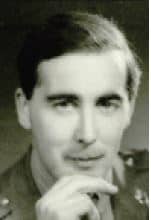Major St Clair Tisdall, who has died aged 92, was awarded an MC in Holland in 1944 when he was commanding a troop of the 8th King’s Royal Irish Hussars.

At two o’clock on the morning of October 22, the battle for s’Hertogenbosch began with a tremendous softening-up barrage. At first light, Tisdall’s squadron advanced up the sandy tracks to the southeast of the town in support of an infantry attack on the village of Middlerode.
They came under heavy fire from an enemy position; two attempts were made to capture it but without success.
It was then decided that two troops of tanks should attack at the same time from different directions. Some of the tanks were knocked out by mines. Others were held up by a dyke. One of the troop leaders was wounded by a sniper.
In what was fast becoming a critical situation, Tisdall drove his troop forward at full speed. Despite being engaged by an anti-tank gun, he pressed on and overran the enemy position. Heavy fire was brought down on him, but he remained firing his guns until the infantry arrived to mop up.
He was awarded an Immediate MC.
The citation for the award paid tribute to his courage and offensive spirit.
Wilfrid St Clair Tisdall, who came to hate his first name and always went by St Clair, was born on April 2 1921 at Altrincham, Cheshire. The son of a rural dean, he was educated at Dean Close School, Cheltenham, where he was head boy and captain of the rugby XV. He went up to Wadham College, Oxford, to read Modern Languages and earned pocket money fire-watching at night on the roofs of prominent buildings.
In 1942 he was commissioned into 8 KRIH and embarked on a troopship bound for Egypt. His bunk was in one of the empty swimming pools. In Cairo, he contracted diphtheria. After recovering, he rejoined the remnants of his regiment in the Libyan Desert.
Two-thirds of the tank squadrons had been lost in action with the Axis forces. While in command of a troop in the battle of Alam Halfa, he was dive-bombed by German Stukas when the screaming sirens did permanent damage to his hearing.
At the Battle of El Alamein, he was ADC to Major-General (later Field Marshal Lord) Harding, GOC 7th Armoured Division. After the Eighth Army broke through, he navigated Harding across the desert using a sun compass. When their armoured car was strafed near Benghazi and turned over, Tisdall suffered injuries to a leg and was treated in Cairo.
Back in England, 8 KRIH was re-equipped with Cromwell tanks and landed in Normandy shortly after D-Day. His tank was engaged by a well camouflaged, self-propelled anti-tank gun and set ablaze. Tisdall’s driver was killed, but he and the rest of his crew managed to get clear.
Promoted to captain on becoming regimental intelligence officer, one morning in April 1945 he was travelling by scout car to collect some important maps when the vehicle skidded into a tree. He was evacuated to England with a suspected fractured knee.
Tisdall saw active service in Korea between December 1950 and early 1952.
After a spell instructing at the Driving and Maintenance School, Bovington, Dorset, he went to Staff College. The following year he rejoined his regiment at Lüneburg, Germany, in command of a squadron and then moved to Bielefeld as Military Secretary to the Commander of the British Corps in BAOR. In 1960 he was posted to HQ Land Forces Persian Gulf in Bahrain as a staff officer and military attaché.
After 18 months at the Ministry of Defence, in 1965 he retired from the Army and became a preparatory schoolmaster teaching Latin and rifle shooting at Packwood Haugh School, near Shrewsbury.
St Clair Tisdall married, in 1947, Prue Dixon. She predeceased him and he is survived by their two daughters.
Major St Clair Tisdall, born April 2nd 1921, died January 20th 2014.



